|
FAQs about Identification of Faviid
Corals 2
Related Articles:
Faviid Corals,
Related FAQs: Faviid Identification 1,
Faviid ID 3, Faviid ID 4 &, Faviids 1, Faviids
2, Faviids 3, Faviid Behavior, Faviid Compatibility, Faviid Selection, Faviid Systems, Faviid Feeding, Faviid Disease, Faviid Reproduction/Propagation,
Stony/True Coral, Coral System Set-Up, Coral System Lighting, Stony Coral Identification, Stony Coral Selection, Coral Placement, Foods/Feeding/Nutrition, Disease/Health, Propagation, Growing Reef Corals, Stony Coral
Behavior,
|
|
|
Faviid ID 7/13/11
Hey WWM
<CD>
I Recently obtained a very nice stony coral for relatively
cheap.
When I initially bought the coral I was told it was a Favia but I
feel this may not necessarily be true.
<I'd wager it IS a Faviid... of the family, but not this
genus>
The Colony is big, probably the biggest coral colony I've
ever owned.
I noticed the corallites do quite a bit of meandering As the Maze
brains do, so this is what lead me
to suspect it may be something other then a Favia,
If possible I'd like a second opinion on this ID.
I attached some photos here so you can check it out.
<My guess is on the genus Platygyra or Goniastrea. Bob
Fenner>
|
|
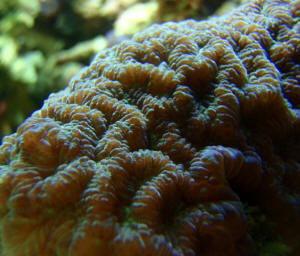 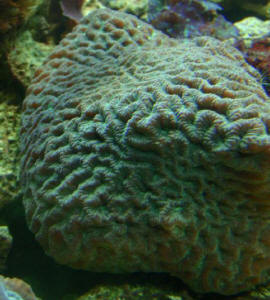
|
|
Scler ID... Fav and Dend - 8/17/10
Dear Bob n crew,
<Hello Blesson>
Greetings!
<Salutations!>
First of all thank you for this awesome site! Has helped me and
my friends in our fishkeeping immensely and changed a whole lot
of our methodology in the hobby. Well I'll try to keep this
mail short to lessen your burden.
<Yay!>
I received 2 corals from a friend and so far I think one is a
Favite of some sort,
<This is a Favia -- notice the individual corallites that do
not have shared walls? I.D. to species level is impossible here,
you would need a bleached skeleton & a copy of Veron's
works w/ a microscope to be sure>
and the other a Turbinaria.
<Yes>
I was thinking it could be a T. frondens or a T. patula or even a
T. peltata.
<I think this is T. peltata.>
Just not sure though. I have obviously done my fair share of
reading and preparation for these two corals (since the last two
months!).
<Great! These are both excellent choices, hardy and
beautiful>
It would be of immense help if you kind folks could help me
identify these specimens, and also let me know if you spot any
bleaching or any such problems from the pictures.
<These look ok to me, a little light in colour but that could
be the pictures. With good care they should be fine>
Hope the pics are not too big.
<they are ok>
The Favite doesn't seem to be acclimatised as of yet as
I've not seen its feeding tentacles or the sweeper
tentacles.
<I've had one for three years + and not seen them either,
but it's grown, albeit slowly>
And the Turbinaria extends its polyps but not as much as I've
witnessed in some of the Turbinaria pictures.
<This looks fine to me>
And just letting you guys know that I've been reading the
dailies regularly for almost six months now and just love all the
info!
<Great!>
Any ways, thanks again in advance for your help. My regards to
Bob, Salty, Neale, Lynn, Chris and the rest of the gang.
Cheers, Blesson.
<Thanks, Simon>
|
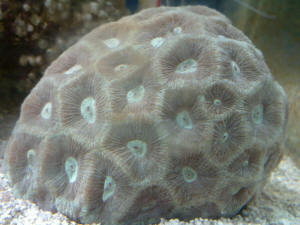 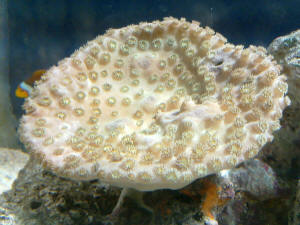 |
|
Re: Favia and Dendrophylliid 8/25/10
Good day ! Bob and crew,
<Hello Blesson! Sorry this has taken me a while to get back to
you, I thought I had checked my in-box and it turned out I had
not>
Hope this mail finds everyone in the best of health and spirits
:)
<Yes thank you! My nurse says that my lungs are at 132%
capacity!>
Well my main reason for writing in today is to confirm the id
given for one of my corals. Simon identified this specimen I am
talking about as a Favia sp. No offense Simon but I was surfing
through a reputed e-tailer's website and they had a picture
that resembles the coral I have almost in every way except for
the colours. It was named reverse prism Goniastrea closed brain
coral.
<Mmmm, no. A Goniastrea would have shared walls between the
corallites, and I believe that each corallite on your coral has
it's own walls. This is THE defining characteristic. Check
Borneman or Veron's books for more reliable I.D methods than
e-tailers, who often do not know which animals they are selling.
This article describes how to I.D these http://www.reefs.org/library/aquarium_net/1097/1097_1.html
'the corallites are separated from each other and are
distinct oval, round, or amoeba-shaped structures which may be
touching but never fusing'. Another possibility could be a
Favites, although distinguishing these and Favia apart is
sometimes difficult as they can be very similar indeed>
And none of the pictures on WetWeb look like what I have, under
the category Favia. Hence the doubt :(. Don't mean to
challenge Simon's knowledge or anything like that, just
making sure what I have is a Favia indeed. Plus I find the info
on Goniastrea care on WetWeb is pretty scanty.
<Is still a Faviid, and it's care is pretty much the same
as the others, so no worries there.>
Could you please be kind enough to re-direct me to those
pages.
<Try here. http://www.wetwebmedia.com/faviidsysfaqs.htm
>
Thanks,
Blesson.
<No worries, Simon>
|
|
Identification of lps/sps
unknown to LFS owner 3/12/10
Hello,
<Hello Travis>
I am looking to identify this bright lime green type of coral,
and after a few hours of fruitless research I thought I'd ask
the capable WWM crew.
<Ok>
LFS owner received a 3-4 inch diameter parent colony, from this
he placed 1/4 in a display tank and sliced the remainder into
frags to be sold,
<I would not have done this with this particular coral>
but the genus and species are unknown to owner and employees.
<Species unknown, yes, but I do think this is a Faviid,
possibly a Favia. See each corallite has it's own, not a
shared wall? This is a clue. Try here:
http://www.wetwebmedia.com/faviidae2.htm>.
I have attached three pictures of this coral: two from outside
the aquarium, and one taken from above with an underwater camera.
Note: these pictures were taken shortly after acclimation and the
coral appears slightly more withdrawn than it did in my LFS.
<This coral appears bleached -- hence the unusual colour, and
why I would not have fragged it -- puts unnecessary stress on an
already stressed coral>
Information to help the identification: total colony is
approximately 1/4 inch across with a 1/4 inch tall stony
skeleton, each polyp is slightly larger than 1/16 inch wide;
<Very small>
it appears to have miniscule feeding tentacles(about 20/polyp,
not seen in pictures) that are out during the day (exposed 10
minutes after placed in tank), these tentacles also have tiny
white spherical nematocyst looking tips.
<Excellent observations, first class>
The colony looks like mini-Favia,
<Yes! The nail hitteth the head!>
if there is such a thing, except that each polyp is nearly a
perfect circle. Coloration is highly fluorescent monochromatic
lime green(picture makes it appear more yellow).
<Bleached>
Cool pic note: in pictures 1 and 2 you can see some Zooxanthellae
goo that appeared seconds after turning the lights on for the
pictures.
<You mean the brown spots?>
The colony currently looks more like picture 3, just add some
tiny tentacles.
Thank you for the many answers over the last few months,
<And thank you as well!>
Travis
<Simon>
|
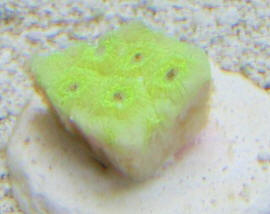 |
|
Scleractinian ID
3/10/10
Hi Crew!
<Ross>
I have been lurking on WWM for a time now in an attempt to
identify a stony coral that was hidden in my tank. It was
obscured by a large rock that I recently traded to the LFS for a
T. peltata specimen. This coral apparently hitchhiked into my
tank about 14 months ago on some live rock that was aquacultured
in Florida (according to the LFS; but it had Arca zebra on some
rocks, so probably is correct) .
<A good clue>
The corallites are about 5mm diameter
<And this>
and the polyps are extended most of the time (please see the
attached picture - between the duster and the snail ).
Interestingly, the polyps facing upward appear to be dead,
whereas the ones facing horizontally, or downward, appear to be
fine. This coral is, and has been, about 24in below the lights
under about 19 in of water.
My hope is that this is a Zooxanthellate coral,
<Is, though not very "pretty" because of,
eh?>
but I thought I would get a second opinion. It is a very nice
addition to my tank and I would like to keep it healthy.
So far, my guesses are (in order of likelihood):
Montastrea annularis
Tubastrea spp.
Favia fagrum
<... Is a Faviid... likely a Montastrea... probably
annularis>
Tank parameters: T = 78-81F, NH3 = 0, N02 = 0, N03 = trace, pH =
7.95-8.20, Ca = 420mg/l, Alk = 8dKH, Mg = 1300mg/l. 72 gal
Bowfront, Aqua C Remora, Fluval 305 w/Chemi-Pure . 10gal weekly
water change with aged RO/DI and Oceanic salt mix. 2x150W HQI,
2x96W T5.
Thank you for your hard work on WWM! It is great to have a
resource to dispel much of the misleading advice and bad science
circulating in the hobby.
Ross
<Thank you for your kind, encouraging words, and sending along
this ID note. Enjoy! Bob Fenner>
|
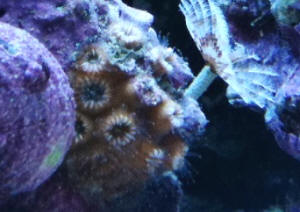 |
|
Favia ID? --
12/08/09
Dear Crew,
<Henk>
I was wondering if you could give an ID for this coral someone in
my neighborhood has put up for sale? I guess it is a Favia. I
found on the internet similar looking corals labeled as Rainbow
Favia, but was wondering if a more specific ID was possible, i.e.
as in a scientific name?
<Mmm, might be Favia pallida, but is almost assuredly at least
a Favia sp.>
I suppose care for this coral does not differ from other Favia
species?
<Mmm, doubtful. Is likely the same as the genus period>
Thanks.
Henk Naert
<Welcome. Bob Fenner>
|
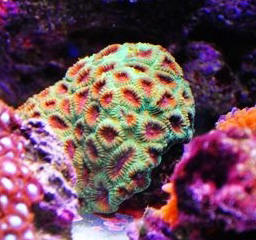 |
Live Rock ID
5/5/09
Hi Crew,
<Roxanne>
I've read your web site for months as we set up our saltwater
tanks.
We've had tanks for about 35 years on and off, but things have
changed dramatically. That's most likely from folks like you
who have disseminated useful and valuable information to this
hobby. Kudos for the great work.
<Thank you>
Now for my question.......
I purchased some live rock which I think came from the Florida
Keys.
It's filled with polyps, sponges and the critter I'm trying
to ID here.
They stand about 1/4 inch off the rock, though the smallest are
still barely above the surface. Even the smallest send out the
polyps you see in the 2nd picture. I'm just curious if you have
any idea what they may be? (Sorry, if the pictures are too large.
Making them small lost all detail - hindering ID.)
Thanks for your help.
Roxanne
<Mmm, given your clue as to origin... and the
prominent/distinctive features of the corallites (deep pits,
alternating protruding and smaller septa...) I do think these are
Hidden Cup Coral, Phyllangia americana
(family Faviidae)... Is mostly found "under rocks and
ledges" in the wild, and often has more color...
reddish-brown. Bob Fenner> |
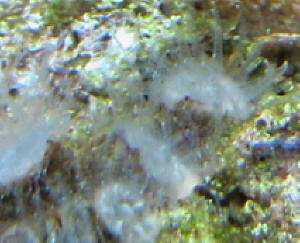 |
| Coral Identification 4/27/08 Hello
and thanks for taking the time to review my email. <Welcome>
I have had a coral for about 2 years now which was originally
identified as Leptastrea pruinosa, however, I have begun to
question the accuracy of that identification. <Mmm, does appear
to be of the genus... Species though... I cannot tell from this
pic> I was hoping you could take the time to have a look and
perhaps lend your thoughts on it. It is an encrusting coral which a
very brittle skeletal base. <Skeletons of biomineralizing life
in captivity are subject to macro- and micro-molecular change...
May well not be as "massive", dense as wild counterparts.
Does appear to be healthy!> The picture is attached and thanks
in advance for your attention. Andrew <Wish I could state a bit
more. Do see Veron's excellent works... for insight into the
particulars of discerning the lower tax. of Scleractinians...
usually microscopic examination of corallites is required. Bob
Fenner> |
|
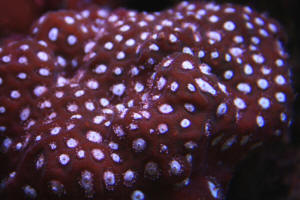
|
|
Is this a Favia Brain Coral?
01/06/2008 <<Hello, Andrew here>> Any ideas? We were
thinking it looked like some type of brain, possibly a Favia. Any
help would be greatly appreciated. <<Yes, that is a Favites
SP. closed brain coral, had one myself, a very nice LPS coral
indeed>> Thanks, Bellinda
<<Thanks for the question, A Nixon>>
|
|
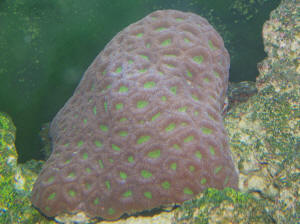
|
Coral Identify? Faviidae...
9/26/07 Hi, <Greetings, Mich here.> Can you help me
identify this species? <Maybe!> Could this be Leptastrea
pruinosa or Acanthastrea echinata? <Does look like a member of
the Faviidae family to me. Leptastrea pruinosa is a possibility. I
don't think this is an Acanthastrea echinata.> It has been
growing for at least two years on this rock, and it grows very
slowly, as you can see by its size. <Is a nice size, and a very
pretty coral.> It has a fuzzy texture, and the blue parts
disappear when disturbed, leaving only the brown. It is quite flat
like a blanket. The apparent depth in the picture is due to it
flowing over the rock. Thanks for the great site!
<Welcome. Mich>
CH |
|
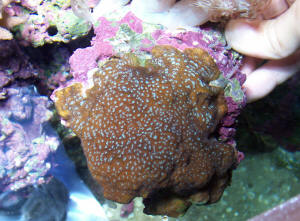
|
|
|

